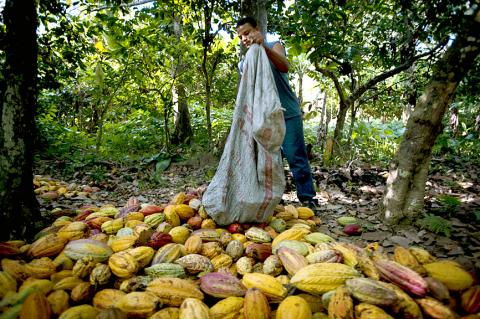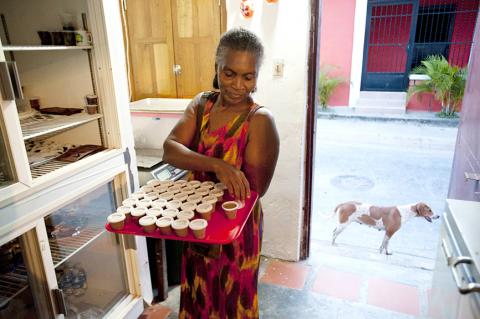As the sun beats down to dry cherished Criollo beans in the main square in Chuao, residents of the village in mountainous northern Venezuela simply say: Behold the world’s best cocoa.
Of course, people in other countries, with chocolate on their happy faces, may beg to differ.
“If you are born in Chuao, your life is tied up with cacao,” Alcides Herrera said, referring to the cacao tree which yields the cocoa bean from which chocolate is made.

Photo: AFP
Since 1976, Herrera’s company, Empresa Campesina Chuao, has produced Venezuela’s only cocoa beans with a coveted appellation certifying their origin.
“As a kid, for example, when I was passing through the square, and you could feel a rainstorm closing in, you would stop to help gather up the beans,” Herrera continued.
“Ours are the world’s best cocoa beans. That has been certified and experts from many countries agree,” he said. “We process by hand with techniques that have been passed down for 400 years.”

Photo: AFP
More than 80 percent of the world’s cocoa comes from the Forastero Cacao Tree and less than one-fifth from Chuao’s Criollo.
Many experts believe the Criollo around here has a singular, tastier bean and they are top-of-the-list ingredients for many of the world’s top chocolate-makers.
Beans from Chuao total about 16 tonnes to 18 tonnes a year; it’s a tiny figure compared with the 18,000 tonnes Venezuela produces each year.
Recently, looking to boost output if possible, the government deemed cocoa beans a strategic crop. Now, 35 percent of the annual take goes to a German firm; 35 percent goes to a new state Venezuelan Cocoa Bean Co; and the remaining 30 percent to local producers.
“We have our eyes on the sky to see if any clouds pop up,” explained Maryoli Chavez, 32, one of more than 1,200 workers at the cooperative. “I like to work on the farm. We all do a bit of everything and make the same money. Some weeks I am on drying duty, other times I am out picking pods or breaking out the seeds.”
On this afternoon, three of Maryoli’s kids were playing at her feet.
The cocoa industry has traditionally been women’s work in Venezuela. Men tend to work in construction or the coastal region’s fishing industry.
On cutting duty, the women wield machetes with skill, lopping off the violet or yellow pods in seconds; a few men trailing behind pick up and transport the pods for processing.
The area is just 100km west of Caracas, but feels a world away as one has to travel in by sea as the town is wedged between a mountain and the Caribbean coast.
Edis Liendo, a local star among cocoa bean processors, has been at it most of her life and is now 60.
“I think the cocoa bean is something from the heavens. It was what the gods used to prepare as a special drink,” Liendo says, hawking candies, liquor and desserts at the door of her home.

The US dollar was trading at NT$29.7 at 10am today on the Taipei Foreign Exchange, as the New Taiwan dollar gained NT$1.364 from the previous close last week. The NT dollar continued to rise today, after surging 3.07 percent on Friday. After opening at NT$30.91, the NT dollar gained more than NT$1 in just 15 minutes, briefly passing the NT$30 mark. Before the US Department of the Treasury's semi-annual currency report came out, expectations that the NT dollar would keep rising were already building. The NT dollar on Friday closed at NT$31.064, up by NT$0.953 — a 3.07 percent single-day gain. Today,

‘SHORT TERM’: The local currency would likely remain strong in the near term, driven by anticipated US trade pressure, capital inflows and expectations of a US Fed rate cut The US dollar is expected to fall below NT$30 in the near term, as traders anticipate increased pressure from Washington for Taiwan to allow the New Taiwan dollar to appreciate, Cathay United Bank (國泰世華銀行) chief economist Lin Chi-chao (林啟超) said. Following a sharp drop in the greenback against the NT dollar on Friday, Lin told the Central News Agency that the local currency is likely to remain strong in the short term, driven in part by market psychology surrounding anticipated US policy pressure. On Friday, the US dollar fell NT$0.953, or 3.07 percent, closing at NT$31.064 — its lowest level since Jan.

The New Taiwan dollar and Taiwanese stocks surged on signs that trade tensions between the world’s top two economies might start easing and as US tech earnings boosted the outlook of the nation’s semiconductor exports. The NT dollar strengthened as much as 3.8 percent versus the US dollar to 30.815, the biggest intraday gain since January 2011, closing at NT$31.064. The benchmark TAIEX jumped 2.73 percent to outperform the region’s equity gauges. Outlook for global trade improved after China said it is assessing possible trade talks with the US, providing a boost for the nation’s currency and shares. As the NT dollar

The Financial Supervisory Commission (FSC) yesterday met with some of the nation’s largest insurance companies as a skyrocketing New Taiwan dollar piles pressure on their hundreds of billions of dollars in US bond investments. The commission has asked some life insurance firms, among the biggest Asian holders of US debt, to discuss how the rapidly strengthening NT dollar has impacted their operations, people familiar with the matter said. The meeting took place as the NT dollar jumped as much as 5 percent yesterday, its biggest intraday gain in more than three decades. The local currency surged as exporters rushed to